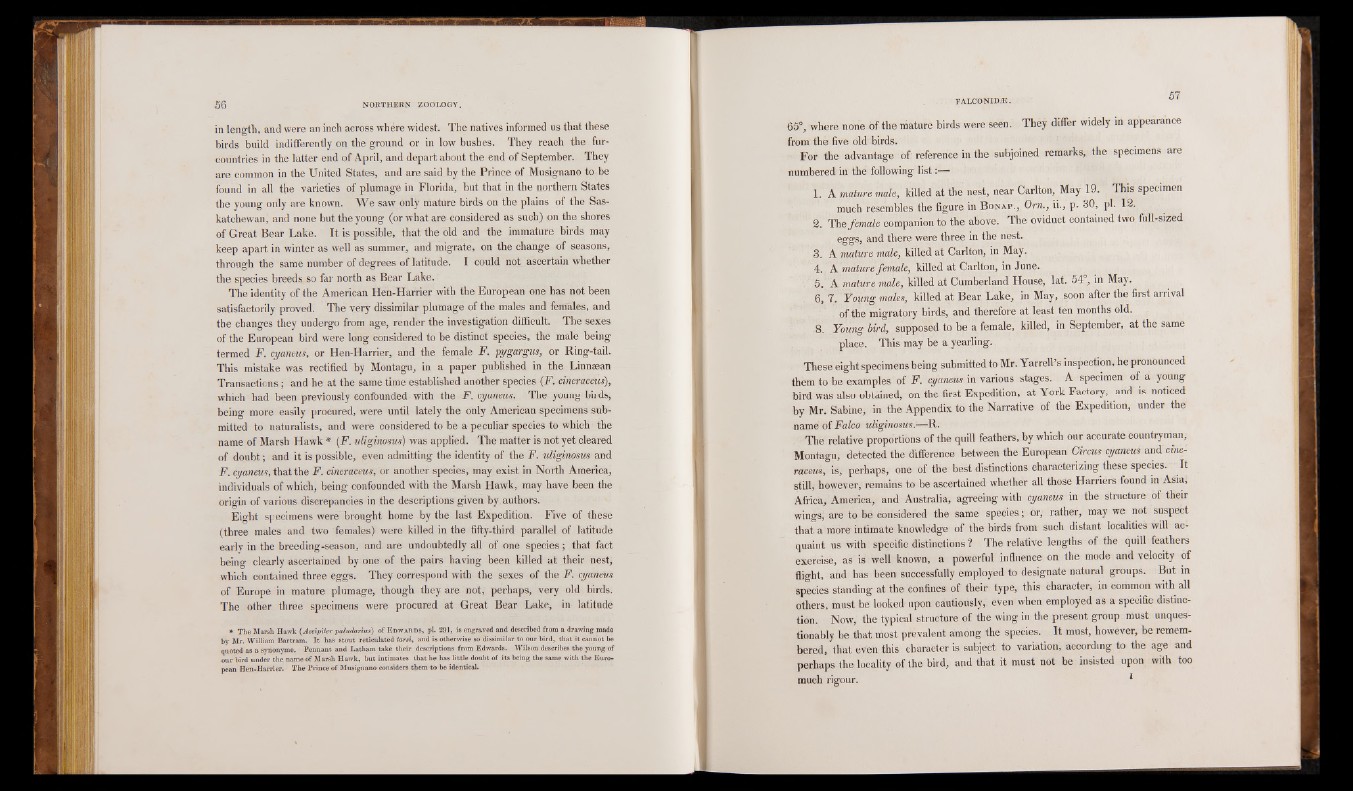
in length, and were an inch across where widest. The natives informed us that these
birds build indifferently on the ground or in low bushes. They reach the fur-
countries in the latter end of April, and depart about the end of September. They
are common in the United States, and are said by the Prince of Musignano to be
found in all the varieties of plumage in Florida, but that in the northern States
the young only are known. We saw only mature birds on the plains of the Saskatchewan,
and none but the young (or what arm considered as such) on the shores
of Great Bear Lake. It is possible, that the old and the immature birds may
keep apart in winter as well as summer, and migrate, on the change of seasons,
through the same number of degrees of latitude. I could not ascertain whether
the species breeds so far north as Bear Lake.
The identity of the American Hen-Harrier with the European one has not been
satisfactorily proved. The very dissimilar plumage of the males and females, and
the changes they undergo from age, render the investigation difficult. The sexes
of the European bird were long considered to be distinct species, the male being
termed F. cyaneus, or Hen-Harrier, and the female F. pygargus, or Ring-tail.
This mistake was rectified by Montagu, in a paper published in the Linnaean
Transactions; and he at the same time established another species (F . cineraceus), which had been previously confounded with the F. cyaneus. The young birds,
being more easily procured, were until lately the only American specimens submitted
to naturalists, and were considered to be a peculiar species to which the
name of Marsh Hawk * (F. uliginosus) was applied. The matter is not yet cleared
of doubt; and it is possible, even admitting the identity of the F. uliginosus and
F. cyaneus, that the F. cineraceus, or another species, may exist in North America,
individuals of which, being confounded with the Marsh Hawk, may have been the
origin of various discrepancies in the descriptions given by authors.
Eight specimens were brought home by the last Expedition. Five of these
(three males and two females) were killed in the fifty-third parallel of latitude
earlv in the breeding-season, and are undoubtedly all of one species; that fact
being clearly ascertained by one of the pairs having been killed at their nest,
which contained three eggs. They correspond with the sexes of the F. cyaneus of Europe in mature plumage, though they are not, perhaps, very old birds.
The other three specimens were procured at Great Bear Lake, in latitude
* The Marsh Hawk {Acoipiter paludarius) of E dw a rd s, pi. 291, is engraved and described from a drawing made
by Mr. William Bartram. It has stout reticulated tarsi, and is otherwise so dissimilar to our bird, that it cannot be
quoted as a synonyme. Pennant and Latham take their descriptions from Edwards. Wilson describes the young of
our bird under the name of Marsh Hawk, but intimates that he has little doubt of its being the same with the European
Hen-Harrier. The Prince of Musignano considers them to be identical.
65°, where none of the mature birds were seen. They differ widely in appearance
from Forth eth feiv ea dovlda nbtiargdes . of reference in the subjoined remarks, the specimens are
numbered in the following list:—•
1. A mature male, killed at the nest, near Carlton, May 19. This specimen
much resembles the figure in B onap.- Orn., ii., p. 30, pi. 12.
2. The female companion to the above. The oviduct contained two full-sized
eggs, and there were three in the nest.
3. A mature male, killed at Carlton, in May.
4. A mature female, killed at Carlton, in June.
5. A mature male, killed at Cumberland House, lat. 54°, in May.
6. 7. Young males, killed at Bear Lake, in May, .soon after the first arrival
of the migratory birds, and therefore at least ten months old.
8. Young bird, supposed to be a female, killed, in September, at the same
place. This may be a yearling.
These eight specimens being submitted to Mr. Yarrell’s inspection, he pronounced
them to be examples of F. cyaneus in various stages. A specimen of a young
bird was also obtained, on the first Expedition, at York Factory, and is noticed
by Mr. Sabine, in the Appendix to the Narrative of the Expedition, under the
naTmhe eo rf eFlaatlcivoe uplriogpinoorstiuosn:s-^ oi-fR t.he quill feathers, by which our accurate countryman,
Montagu, detected the difference between the European Circus cyaneus and cineraceus,
is, perhaps, one of the best distinctions characterizing these species. : It
still, however, remains to he ascertained whether all those Harriers found in Asia,
Africa, America, and Australia, agreeing with cyaneus in the structure of their
wings; are to be considered the same species; or, rather, may we not suspect
that a more intimate knowledge of the birds from such distant localities will acquaint
us with specific distinctions ? The relative lengths of the quill feathers
exercise, as is well known, a powerful influence on the mode and velocity of
flight, and has been successfully employed to designate natural groups. But in
species standing at the confines of their type, this character, in common with all
others, must be looked upon cautiously, even when employed as a specific distinction.
Now, the typical structure of the wing in the present group must unquestionably
be that most prevalent among the species. It must, however, be remembered,
that even this character is subject to variation, according to the age and
perhaps the locality of the bird, and that it must not be insisted upon with too
much rigour. 1